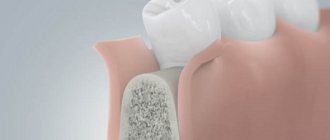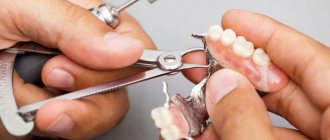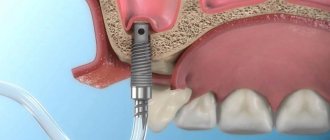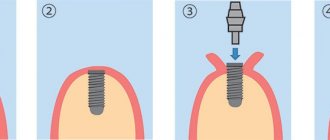Absolute contraindications to dental implantation
When is implant placement not possible? Experts highlight a list of diseases that are considered absolute contraindications to implantation and any other operations. These are, first of all, severe disruptions to the functioning of the main systems of the body: cardiovascular, nervous (both central and peripheral), endocrine, circulatory.
Here are examples from the list of contraindications for the installation of dental implants:
- diabetes mellitus in the decompensated stage
- malignant neoplasms (implantation can accelerate tumor growth and spread of metastases)
- autoimmune diseases
- chronic renal or liver failure
- connective tissue diseases
- osteoporosis
- bruxism and hypertonicity of the masticatory muscles
- hemocoagulation (blood clotting) disorders
- tuberculosis
- mental disorders
- chronic alcoholism and drug addiction
Also, a contraindication to implantation is a condition where tissue restoration is impaired. It can occur after a course of chemotherapy, organ transplantation, and also with immunodeficiency. If the patient takes anticoagulants or cytostatics that slow down the development and division of cells, the risk of implant rejection is very high.
Finally, one cannot fail to mention the allergic reaction to local and general anesthesia, which makes any surgical intervention impossible. It is also included in the list of absolute contraindications for dental implants.
Relative (temporary) contraindications to implantation
Unlike absolute contraindications, relative contraindications for dental implantation allow the procedure to be performed under certain conditions. For example, after changing lifestyle, eliminating inflammatory processes, recovering from conditions incompatible with surgical intervention, and the like.
What contraindications for installing dental implants are considered relative? Here are the main ones:
- insufficient bone volume
- malocclusion
- inflammatory processes and neoplasms in the oral cavity (cysts, granulomas)
- caries
- periodontitis and other gum diseases
- poor oral hygiene, tartar
- pregnancy and breastfeeding
- viral infections
- exhaustion of the body, poor nutrition and severe stress
- smoking more than one pack of cigarettes per day
- engaging in extreme sports that increase the likelihood of injury
Many of the above conditions can be corrected: bone tissue can be built up using a bone grafting procedure, the bite can be corrected with braces, and hard deposits can be removed. It will also be necessary to treat caries and other oral diseases before implantation. In certain conditions, the doctor will require you to adjust your lifestyle by limiting the number of cigarettes you smoke, establishing proper nutrition and reducing physical activity. Pregnant and lactating women should wait until childbirth and the end of lactation.
Among the relative contraindications for the installation of dental implants are a number of diseases that require increased monitoring by doctors, for example, compensated diabetes mellitus.
When you can and cannot install dental implants - a complete list of dos and don’ts
Article navigation
- What are the indications?
- Contraindications to dental implantation
- Absolute contraindications
- Relative contraindications
- Age restrictions for implantation
- Features of implantation in women
- Limitations for bone atrophy
- Dental restoration for periodontitis, periodontal disease, osteoporosis
- Diabetes mellitus and implantation
- Restrictions for hepatitis
- Bad habits and contraindications
- Preparation is the foundation of subsequent treatment
- Complications after implantation
- Prohibitions after installation of dental implants
- Can you trust the reviews?
Question for a specialist
Implantation is the right solution to problems in the absence of any number of teeth.
Unlike traditional prosthetics - removable or fixed - there are no impossible tasks for it. But, unfortunately, it is not indicated for all patients. Therefore, the first step before restoring teeth will be to identify possible contraindications to implantation and, if necessary, eliminate them.
Introduction
Patients very often try to postpone the dental implant procedure. What guides patients and doctors in their decision to place or not place an implant? What happens to bone tissue and gums when a tooth is missing. When can placing an implant help a patient?
Introductory information about the consultant:
The chief physician of the Research Center, Ph.D., answers patient questions. implantologist Dakhkilgov M.U. The word of an expert in the field of implantology is always important. Why is dental implantation an important component of dental health? And when is it absolutely necessary, and when can implantation be postponed?
Magomed Umatgireevich is a surgeon who has personally installed a huge number of implants from almost all leading manufacturers - such as Nobel, Straumann, Astra Tech, Ankylos, Bredent. Doctor to whom patients come from all over the world:
Magomed Dakhkilgov is the chief physician of clinics founded in 2010, which confidently occupy the highest places in professional ratings for implantology in Moscow and Russia.
IMPORTANT! Financial support for dental implantation
Do you want to undergo high-quality dental implantation in our clinics, but have a financial problem? This can be solved! From July 20, 2020
You can also use the dental implantation service in the clinics of the German Implantology Center in installments.
Before we talk about dental implantation itself, let's talk about the factors that precede it. After all, installation of an implant becomes necessary when a person loses a tooth.
What are the indications?
Indications for dental implantation are as follows:
- the absence of one tooth along with the root: as an alternative, the patient can choose only a bridge prosthesis, which, when installed, will affect and even injure two lateral supporting teeth (and also shorten their service life),
- missing several teeth in a row,
- the tooth is almost completely destroyed, but the root remains: in such cases, a one-step technique is possible, when, when the root is removed, an implant is immediately installed in its socket. The only limitation is that the removal should not be emergency, but planned,
- scattered absence of several teeth in the oral cavity: one of the most difficult problems, since with the classical approach the doctor may recommend installing either several bridges or uncomfortable removable dentures,
- absence of end teeth in a row: an even more complex problem, since only a few types of removable structures, which are additionally fixed to the supporting teeth, can cope with it,
- complete adentia or absence of all teeth in the oral cavity: previously, a patient with such a diagnosis had to be content with only removable orthopedic structures,
- intolerance to removable dentures: for example, allergic reactions to synthetic materials.
DENTAL PROSTHESIS WITH 4 OSSTEM IMPLANTS FOR 1 JAW - RUB 130,000.
Implantation even with bone tissue atrophy. Work guarantee! Save RUR 20,000.
on promotion >> Free consultation with an implantologist +7 (495) 215-52-31 or write to us
Myth 4. “Implantation is done under general anesthesia, causing harm to the heart”
In most cases, there are no indications for general anesthesia, and patients are implanted under local anesthesia. At the same time, they are conscious, observe and partially control the situation, and respond to the doctor’s requests.
The myth about the dangers of general anesthesia for the heart has been entrenched in the mind since the times of Soviet medicine, when potent and harmful drugs were used for anesthesia. Pharmacology has made great strides forward, anesthesia has become effective and less dangerous. Although it puts a short-term and harmless load on the kidneys and liver.
Igor Bondarev, St. Petersburg
“The global nature of my dental problems is largely explained by the fact that I tried to avoid dentists all my life. Naturally, when there are 9 diseased teeth left in the oral cavity, and not a single healthy one, it’s time to reconsider the situation. I mentally understood that I needed to do implantation, but at the same time, the fear of any medical manipulations held me back. Having assessed the scale of the disaster, the doctor offered me general anesthesia. And so they did. The operation lasted more than an hour and a half - at the bottom they installed a common bridge on implants, but at the top they installed 4 separate classic ones, in general - they tinkered with me. I’m glad I wasn’t “present” at this!”
Absolute contraindications to implant installation
- unstable diabetes mellitus: blood glucose level above 6-8 g/mmol,
- autoimmune pathologies: lupus erythematosus, Behcet's disease, Sjogren's syndrome, pemphigus (pemphigus),
- tuberculosis,
- serious diseases of the nervous, endocrine and cardiovascular systems,
- hypertonicity of the masticatory muscles,
- diseases of the blood and lymphatic system: anemia, bleeding disorders (hemocoagulation), leukemia, lymphogranulomatosis,
- malignant tumors: in the absence of remission,
- inability to use anesthesia,
- severe atrophy of bone tissue: when it is impossible to carry out bone augmentation, and your own bone volume is not enough to install even the most advanced implants,
- rheumatoid and rheumatoid arthritis,
- psychical deviations.
Solution: in most cases, classic removable dental prosthetics is indicated, less often – fixed prosthetics.
Is bone augmentation required?
In most cases, if possible, the dentists of our clinic try to choose a more gentle and rapid express treatment method in order to avoid bone buildup due to atrophy. However, if the procedure is unavoidable, we perform it on older patients for the same reasons as others.
Low bone height, thinning in width - due to these problems, placement of an implant may not be possible. This is especially critical for the upper jaw. The alveolar ridge is extremely susceptible to atrophy, and already 2.5-3 months after tooth loss, the bone begins to dissolve in this place.
If there is a similar problem, the dentist may offer the patient a closed or open sinus lift of the jaw. A closed one is preferable - it is more gentle and bloodless. When performing it, you do not need to wait until the bone tissue is formed. You can immediately install the implant, and osseointegration - fusion with the bone - will occur as the bone tissue matures.
We also note that if it is possible to use a modern method and do without bone augmentation, AcademStom dentists try to recommend this treatment protocol to the patient. Extension prolongs the duration of therapy and delays the final result - permanent fixed prosthetics.
Relative contraindications to implantation
- age up to 18-20 years,
- pregnancy, lactation and some other conditions of the female body: low levels of the hormone estrogen, for example,
- weakened immune system: after a long illness or HIV infection. Depending on the severity of the disease, the ban may last up to 1 year.
- hypertension: if you have high blood pressure, you need to be treated by a therapist,
- sinusitis: the proximity of inflamed areas to implants in the upper jaw can cause problems with their implantation,
- diseases of the oral cavity: the presence of caries, stomatitis, inflammatory processes,
- insufficient oral hygiene: this point may well become an absolute contraindication to any prosthetics, because an increased bacterial background will ultimately lead to peri-implantitis. The patient needs to undergo professional oral hygiene and learn how to properly brush teeth independently (the dentist will give recommendations),
- venereal diseases,
- periodontitis, periodontal disease, osteoporosis and osteomyelitis of the jaw: are considered a contraindication only for classical two-stage implantation,
- lack of bone tissue in the jaw in height and width,
- bruxism (teeth grinding) and malocclusion,
- consumption of alcohol and drugs, smoking: incl. and in the past.
Solution: exclusion of contraindications and installation of implants (and prosthesis on them).
A relative contraindication to implantation is an acute period of acute respiratory viral infection in the patient, the need to go to the hospital for emergency or planned treatment, participation in sports competitions (especially traumatic ones), early departure on vacation or a long business trip.
All future patients should remember that installing dental implants is a minor surgical operation. And the tissues (bone and gums) damaged during the procedure must be restored as soon as possible so that the implants can take root well and serve for many years.
Let's now turn to special cases where relative contraindications (or those points that were previously considered contraindications) can be circumvented.
What to pay attention to when undergoing implantation in old age
Patients over fifty years of age who decide to have the procedure need:
- be examined for chronic diseases that can cause rejection of the artificial root;
- tidy up your teeth and gums;
- carefully monitor oral hygiene.
At the time of visiting the dental office, a person must be completely healthy. It is advisable for a woman during menopause to be examined for osteoporosis , and if it is detected, undergo a course of treatment.
Age restrictions for implantation
Dental implants begin to be placed at the age of 18, but not because this is the age of full legal capacity of a person. And due to the peculiarities of ossification of the skeleton, the jaw bones are fully formed and gain strength usually by 18-20 years.
There is no upper age limit for getting implants. Those. even patients “90+” years old can fully undergo the most modern dental restoration. The main thing is that your health allows you to do this. By the way, implantation rejuvenates the face not only due to new teeth, but also due to the effect of “lifting” wrinkles, because The chewing process is normalized, and the “framework” facial muscles are activated.
How ICDI ROOTT reduced the list of contraindications
Thanks to new implantation techniques, the RUTT Dental Implantation Center performs operations on people who were rejected in other clinics due to the diagnosis:
- Hepatitis
With this disease, metabolic processes are disrupted, resulting in increased bleeding. Usually, this is an indication to refuse surgery, but not at the ROOTT center.
- HIV AIDS
Immunodeficiency pathologies disrupt the process of tissue regeneration and reduce resistance to infections. But with ROOTT implants, intervention is possible (under certain conditions).
- Diabetes
Excess glucose provokes inflammation, leads to the leaching of minerals from the enamel, causes bacterial infections and candidiasis. In compensated type II diabetes, implantation is possible.
- Age restrictions
With age, bone tissue decreases, metabolic processes and regeneration slow down. This has long been the reason for refusals from surgery. In RUTT dentistry, operations are performed on patients even after 80! The oldest patient at the clinic is 83 years old.
Features of implantation in women
Pregnancy and lactation are contraindications to the installation of implants, since hormonal levels change, bone density decreases - the implants may simply not take root. Also prohibited are certain types of anesthesia that penetrate the placental barrier and breast milk (epinephrine). It is better to install implants 3 months before pregnancy or 6 months after breastfeeding ends.
It is better not to place implants during menstruation, because... the number of platelets decreases by 2 times. Namely, these blood cells promote tissue healing, incl. and around implants. Menopause does not become a contraindication in itself; changes in a woman’s hormonal levels require the doctor to plan detailed implantation.
What is recommended in the postoperative period
After surgery, you must strictly follow the doctor's instructions. Caring for implants is not difficult. The main thing is not to be lazy, monitor oral hygiene, use dental devices: brush, floss, irrigator.
If everything went without complications, the process of osseointegration of the pin into the tissue will proceed quickly. You should not overload the structures; it is better to avoid solid food for the first weeks. Plus, periodic visits to the dentist will only benefit you.
Following your doctor's recommendations will extend the life of your implants.
Limitations for bone atrophy
After the tooth is removed along with the root, the chewing load stops coming to the jaw bone, and the bone substance gradually atrophies. This process occurs in 90% of people, and its speed is very high - in just 1 year the bone sags to its maximum. And if the patient wants to get an implant, then most likely there is simply not enough space for the new metal “root”. To replenish the volume, bone substance needs to be built up - and then you need to wait about 6 months for it to take root. This approach is applicable to the classic two-stage technique, when you need to restore 1-2 teeth.
Modern methods of one-stage implantation imply immediate installation of a prosthesis - and the orthopedic design additionally splints the implants and prevents them from moving. Implants immediately transfer chewing pressure to the atrophied bone substance, which begins to regenerate. Plus, implants can be placed at an angle to cover more bone. It is possible to place implants that are firmly fixed in areas generally not subject to atrophy - using basal and zygomatic implantation.
Dental restoration for periodontitis, periodontal disease, osteoporosis
Periodontitis and periodontal disease are pathologies in which atrophic processes occur in the gums and jaw bones. In the later stages of the disease, especially when they have taken a generalized form, they are accompanied by inflammation and pain.
Previously, dental implantation with such diagnoses was not performed - they were considered contraindications due to possible complications[1]. But now doctors even recommend placing implants, because... they prevent bone atrophy. However, you need to understand that the remaining diseased and shaky teeth will have to be removed, because they are the source of the accumulation of pathogenic microorganisms.
Read on the topic: why periodontitis and periodontal disease are not a death sentence for implant prosthetics.
With osteoporosis, the bone substance becomes thin and brittle. But it is quite possible to install implants with the simultaneous replanting of bone chips, and also to choose, again, stronger sections and areas for attachment.
Risk factors
These are conditions that are not contraindications, but may reduce the effectiveness of the intervention, require parallel treatment, or for which implantation is considered as a method of intervention.
In these conditions, it is more difficult to achieve a positive result, additional efforts are required, the rehabilitation stage is longer, and the success rate is lower.
The list includes: dysfunction of the maxillary joint, periodontitis, periodontal disease. This also includes smoking and age.
Diabetes mellitus and implantation
Diabetes mellitus affects the entire body - bone tissue becomes sparse, wounds heal poorly, immunity decreases, and periodontitis appears. And, as a result, a person begins to lose teeth. Which, in turn, is again very harmful to the body - the gastrointestinal tract, kidneys, and heart suffer. Here, implantologists also recommend placing implants - for example, according to the all-on-6 protocol or using the basal method, if diabetes is in the compensation stage. Depending on the clinical situation, any minimally invasive one-stage technology may be suitable, because Only 1 puncture operation is needed, which is an advantage for poorly healing injuries.
Keep in mind that the dentist needs to know about the type of diabetes (1 or 2, because in the first type the bones are less dense) and the duration of maintaining glucose levels within normal values.
“I probably visited five or six clinics, and nowhere was it recommended that I undergo implantation because of diabetes, although my sugar has long been normal. They offered to put removable dentures on me, but it was already a negative experience, so I looked further. And I finally found a doctor who gave me some special implants that are safe from diabetes or periodontitis. And what I liked most was that I could eat normally almost immediately, it’s very cool!”
Anna Vladimirovna, review on the website stomatology.rf
Myth 1. “It hurts.”
Anesthesia reduces pain and discomfort during implant installation to almost zero. It is introduced in stages, before performing the manipulations the doctor will make sure that the desired area is insensitive. Installing an implant is a quick procedure; the freezing will not have time to go away.
If an impressionable person sits in the implantologist’s chair, it is difficult for him to bear the sight of blood, the sounds of implants being implanted into the bone, etc., but we are not talking about severe pain.
In some clinical cases, the patient is put into deep medicated sleep, relieving pain and fear.
Irina Fedenko, Moscow
“When I came for a consultation about dental implantation, I was very interested in the question of how painful it was. The doctor asked me what dental procedures I had had in my life. I answered that I naturally treated caries, about 10 years ago I had an unerupted wisdom tooth removed, and they also removed a cyst on the root of the tooth - the tooth itself was saved. Then they told me that problematic tooth extraction and tooth-preserving surgery are more invasive procedures compared to implantation. Therefore, this time there will be less discomfort. Now having experience, I can say that implantation is only scary psychologically, there is no severe physical pain. Although after the operation I naturally suffered for a couple of days. The cheek was swollen, the eye was swollen, the stitches itched and throbbed. But it’s not scary anymore.”
Bad habits and contraindications
Alcohol, cigarettes and drugs weaken the tissues of the oral cavity. Toxins, combustion products, and high-temperature smoke reduce the ability of gums to recover and impair the production of saliva (which maintains a normal environment in the mouth). Experts have found that in smoking patients, implants are rejected 2 times more often than in people without bad habits. For example, the 5-year survival rate of implants is 97-98%, while for smokers it is only 85%. And every year this percentage falls.
Therefore, you need to give up any bad habits - first of all, for your own health, and secondly, in order to wear implants for many years without complications.
If you take into account how long before implantation you need to quit smoking, dentists estimate a period of 2-3 weeks. It is also not recommended to start smoking after the installation of implants.
Preparation is the foundation of subsequent treatment
Before dental implantation, the doctor will definitely examine the condition of the oral cavity for the presence of any diseases and will definitely eliminate them. In addition, the patient needs to undergo an X-ray examination - cone beam or multispiral computed tomography of the jaw and undergo a series of tests.
Based on the diagnostic data, the dentist will plan the implantation. In special computer programs, the models and number of implants are selected for a specific patient, and they are placed on a virtual “jaw”. Additionally, surgical templates are printed to ensure precise placement of the implants so that they are placed in the specified areas and can withstand chewing loads for many years.
Complications after implantation
In order for implantation to take place efficiently and without possible complications (peri-implantitis or rejection), it is important to approach its preparation very carefully. Which, unfortunately, is not done in all clinics. There are cases when systems were installed only on the basis of a targeted X-ray image - which does not reflect the three-dimensional structure of the bone, does not show the maxillary sinuses and nerve bundles. Such neglect of truly informative diagnostics is fraught with installation errors. As a result, the implant can damage the bottom of the maxillary sinus or the trigeminal nerve in the lower jaw.
The patient needs to tell the doctor about possible problems with the body (sudden or chronic). Remember that even the slightest weakening of the immune system immediately before or immediately after implantation can lead to subsequent implant rejection.
Prohibitions after installation of dental implants
For normal rehabilitation of the patient, as well as for high-quality engraftment of the structures, you need to remember that after implantation there are a number of contraindications. These contraindications relate to food intake and a person’s lifestyle. For example, after a two-step protocol, for 2 weeks you need to eat only soft foods, mashed or pureed, because... Pressure cannot be applied to installed implants (they are not splinted with a prosthesis).
With one-stage implantation, after installing the prostheses, you need to start chewing - boiled vegetables, cutlets (after all, here the implants are splinted with a prosthesis and an adequate load will only speed up their osseointegration). But hard foods are also prohibited.
In the first weeks after implantation, physical activity, going to the sauna, bathhouse or cold pool, and flying on airplanes are contraindicated. It is better to postpone training in potentially traumatic sports for 2-3 months. Do not apply warm or hot compresses to your face. But cold ones are possible (especially on the first day after surgery). And don't forget about oral care. In the first day or two, you should not rinse your mouth or brush your teeth. And then you need to start using the brush and paste carefully and carefully so as not to damage the seams.
Can you trust other people's reviews about contraindications?
When it comes to indications and contraindications for dental implantation, you should listen only to your implantologist, who has established himself as an experienced specialist who is constantly improving his skills in the field of implantation. Any opinions of neighbors, friends and relatives (even if they have recently received implants) will not be the opinion of a professional, and therefore require verification. After all, progress does not stand still, and what was prohibited yesterday may no longer be considered a contraindication today.
[1] Ber M., Missika P., Giovagnoli J.-L., “Elimination of complications of implantological treatment” / 2007 – 349 p.
Author: Zhilenko E. A. (Thank you for your help in writing the article and the information provided)









